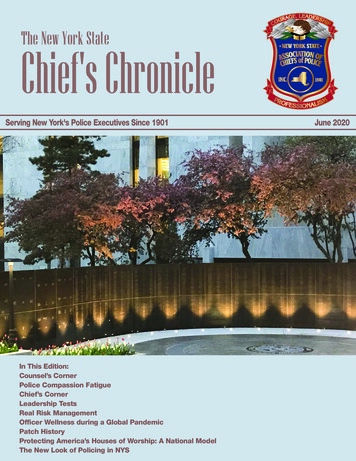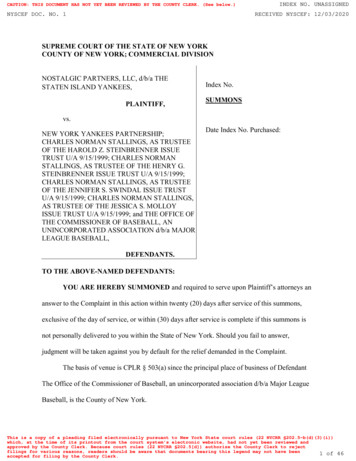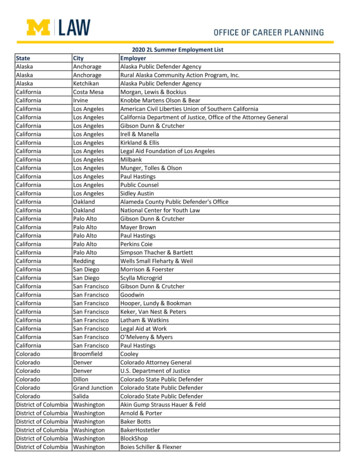
Transcription
The New York StateChief's ChronicleServing New York's Police Executives Since 1901In This Edition:Counsel’s CornerPolice Compassion FatigueChief’s CornerLeadership TestsReal Risk ManagementOfficer Wellness during a Global PandemicPatch HistoryProtecting America’s Houses of Worship: A National ModelThe New Look of Policing in NYSJune 2020
Committed toyour Community.AT PERMA, WE DON’T THINK OF OURSELVESAS JUST A WORKERS’ COMPENSATION PROVIDER.We’re tightly woven into the very fabric of your community.Just as you look out for your family, friends and neighbors, we’ll always be there for you. Doing more thanwhat’s expected to help you and your loved ones so you can keep your community safe and strong. That’s why we created New York State’s first and only crossing guard training program. Why we subsidized a family’s lengthy hotel stay when one of our injured members washospitalized out of town. Why we brought food and clothing relief to a county member after catastrophic floodingduring a hurricane.We go well beyond workers’ compensation to offer you everything from comprehensiverisk management training, a personalized claims team, and patient advocates,to fraud detection, wellness programs and transitional duty services.To find out more contact:Leah Demo, Sales Executive at 888-737-6269 ext. 22142,Cell: 323-807-8677, or ldemo@perma.orgTony Cassaro, Sales Executive at 888-737-6269 ext. 22124,Cell: 518-221-3970, or acassaro@perma.orgP O B O X 1 2 2 5 0 , A L B A N Y, N Y 1 2 2 1 2 8 8 8 - 7 3 7 - 6 2 6 9 W W W . P E R M A . O R G
contentsIn this issue4IGNITION INTERLOCK DEVICESBy Chief (Ret.) Mark Spawn.COUNSEL’S CORNER5By Chief (Ret.) Michael D. Ranalli, Esq.791316POLICE COMPASSION FATIGUEBy Konstantinos Papazoglou, Ph.D., Steven Marans, M.S.W.,Ph.D., Tracie Keesee, Ph.D., and Brian Chopko, Ph.D.CHIEF’S CORNERBy Chief Stuart Cameron, Suffolk County Police DepartmentLEADERSHIP TESTSBy Chief (Ret.) Greg Veitch18 CAMILLUS POLICE RESPONSE TO PERSONS AFFECTED BYMENTAL ILLNESS: THE ONE MIND CAMPAIGNBy Chief Thomas Winn22OFFICER WELLNESS DURING A GLOBAL PANDEMICBy Gregory Drake, Ph.D. Senior Research Associate Centerfor Public Safety Initiatives at the Rochester Institute ofTechnology and Irshad Altheimer, Ph.D. Director Center forPublic Safety Initiatives at the Rochester Institute ofTechnologyPATCH HISTORYPROTECTING AMERICA’S HOUSES OF WORSHIP:A NATIONAL MODELBy Vincent J. Bove25COMMUNICATING WHEN IT COUNTS:SUPPORTING LAW ENFORCEMENT CRISIS NEGOTIATORSIN THE EMPIRE STATEBy Meghan Dudley and James Turley, New York State Divisionof Homeland Security and Emergency Services26BUILDING POLICE OFFICER PSYCHOLOGICAL CAPITALTO MITIGATE STRESSBy Eric Murray, Ed.D30CHIEF (RET.) SCHENECTADY PDGTSC LiaisonDOMINICK G. MACHERONEDEP. CHIEF (RET.) GLENVILLE PDDirector of Research,Development, and TrainingCHIEF LARRY EGGERTLOCKPORT PD (RET.)TreasurerSTEVE CONNERMTA ASSISTANT CHIEF (RET.)Board and OfficersPresidentCHIEF PATRICK PHELANGREECE POLICE DEPARTMENTBy Gordon Graham21Executive DirectorMICHAEL GERACIPOLICE SUICIDEINTERNET SAFETY TIPS FOR PARENTS17 REAL RISK MANAGEMENT20New York StateAssociation of Chiefs of PoliceStaffTHE NEW LOOK OF POLICING IN NYSFirst Vice PresidentCHIEF TIMOTHY PARISIILION POLICE DEPARTMENTSecond Vice PresidentCHIEF KEVIN SYLVESTEROSSINING POLICE DEPARTMENTZone 1 Rep.CHIEF MARTY FLATLEYSOUTHOLD POLICE DEPARTMENTZone 2 Rep.COMM. KENNETH O. JACKSONGARDEN CITY POLICE DEPARTMENTZone 3 Rep.ASST. CHIEF SEAN MONTGOMERYMTA POLICE DEPARTMENTZone 4 Rep.CHIEF GREGORY AUSTINRYE BROOK POLICE DEPARTMENTZone 5 Rep.CHIEF JOSEPH SINAGRASAUGERTIES POLICE DEPARTMENTRetired Member Rep.CHIEF (RET.) JOSEPH DEL BIANCOMAMARONECK POLICE DEPARTMENTThird Vice PresidentCHIEF DANIEL DENZWEST SENECA POLICE DEPARTMENTImmediate Past PresidentCHIEF JOHN ARESTAMALVERNE POLICE DEPARTMENTPast PresidentCHIEF MICHAEL LEFANCHECKBALDWINSVILLE POLICE DEPARTMENTZone 6 Rep.DEP. CHIEF MICHAEL WOODSCOLONIE POLICE DEPARTMENTZone 7 Rep.CHIEF THOMAS WINNCAMILLUS POLICE DEPARTMENTZone 8 Rep.CHIEF F. MICHAEL CATALANOCORTLAND POLICE DEPARTMENTZone 9 Rep.CHIEF SHAWN HEUBUSCHBATAVIA POLICE DEPARTMENTZone 10 Rep.CHIEF JAMES MICHELLACKAWANNA POLICE DEPARTMENTU.S. Attorney’s LiaisonCHIEF (RET.) SAMUEL PALMIERETONAWANDA POLICE DEPARTMENTVACANTNYPD LIAISONA publication of theNew York State Association of Chiefs of Police, Inc.24 Century Hill Drive, Suite 002, Latham, New York 12110Office: 518-355-3371Do you have an interesting law enforcement story or an article you would like tosubmit, photographs of member activities or field scenes?Contact the editor: Larry Eggert at leggert@nychiefs.orgCopyright 2020 New York State Association of Chiefs of Police, Inc.All rights reserved. No part of this publication may be reproduced in any form or by any means,electronic, mechanical or otherwise without prior written permission from the publisher.The New York State Chief’s Chronical magazine is an official communication tool of theNew York State Association of Chiefs of Police, Inc. The New York State Association ofChiefs of Police, Inc. does not assume responsibility for statements of fact or opinion madeby any contributor. Comments made by individuals may not reflect the official position of theNew York State Association of Chiefs of Police, Inc. Acceptance and publication of articles,advertisements, products and services does not indicate endorsement of same by the NewYork State Association of Chiefs of Police, Inc., and the New York State Association ofChiefs of Police, Inc. assumes no responsibility for their accuracy.June 2020 The New York State Chief’s Chronicle
On the Cover:Pictured on the cover is a beautiful evening view of the New York State PoliceOfficers Memorial.Every year in May, law enforcement professionals, families, loved ones andfriends gather in Albany for the New York State Police Officers’ MemorialRemembrance Ceremony, which honors those brave men and women who madethe ultimate sacrifice in service to their communities. This year, a video tributewill recognize the 55 officers whose names will be added to the Memorial’sblack granite wall this year and remembers the 1,567 other officers honoredduring past ceremonies at the Memorial on the Empire State Plaza. A new datefor the 2020 ceremony, postponed due to the COVID-19 global pandemic, hasnot yet been announced by the state Division of Criminal Justice Services, whichcoordinates the event. The 51 men and four women recognized this year servedwith the following agencies: the Cayuga County Sheriff’s Office, Harrison PoliceDepartment, New York City Police Department, New York State Departmentof Environmental Conservation, New York State Police, Port Authority PoliceDepartment, and Suffolk County Police Department. Two NYPD officers werekilled in the line of duty in 2019 and 53 officers died from illnesses resultingfrom their work at Ground Zero in the wake of the 9/11 terrorist attack at theWorld Trade Center. Every officer honored at the Memorial – and their familiesand loved ones they have left behind – will never be forgotten.To view the video tribute, visit:https://www.youtube.com/watch?v VAP8RWVmXSEIgnition Interlock DevicesUpdated Training Video for New York State Law EnforcementBY CHIEF (RET.) MARK SPAWNThe New York State Division of Criminal Justice Services, Officeof Public Safety and Office of Probation and CorrectionalAlternatives is pleased to announce the online release of anupdated video developed by the New York State Association ofChiefs of Police titled “Ignition Interlock Devices in New YorkState.” Individuals completing the trainingcan submit their information at the end ofthe session to receive a training certificateissued from DCJS. Additionally,individuals who appear in the Policeand Peace Officer Registry will havetheir training record updated to includesuccessful completion of the training.This training will provide comprehensiveoverview of Ignition Interlock Devices how they appear, how they work, commoncircumvention tactics, and enforcementguidance for New York State policeofficers. It was produced by the New YorkState Association of Chiefs of Police and4 The New York Chief’s Chronicle June 2020funded by the National Highway Traffic Safety Administration with agrant from the Governor’s Traffic Safety Committee.This training will provide the opportunity to learn about theirappearance, functionality, driver license restriction codes, andVehicle and Traffic Law sectionsfor enforcement. The training isapproximately 20 minutes in durationand is followed by a brief review of thekey takeaways from the video.If you have any questions about thetraining, computer system requirements,or technical difficulties, please contactMatt Slater by email at matthew.slater@The video training provides an overview of what dcjs.ny.gov or by telephone at 518-485street cops needs to know about ignition interlock 5115. The training can be found at thedevices, including common circumvention following link:techniques. Police officers completing theonline training can receive credit to their MPTC g record.other/Ignition-Interlock/story.html
Counsel’s CornerAbove All Else: Why Officer SafetyMust Be a Top Agency PriorityBY CHIEF (RET.) MICHAEL RANALLI, ESQ.As I write this article, we are in the middle of a crisis andlockdown without precedent in recent history. While I amretired from active law enforcement, I remain involved asa police trainer and policy consultant through my job at Lexipol.As a result, I carefully watch and listen to how law enforcementis adapting to this crisis and handling the risk it creates for firstresponders. Obviously, officer safety is paramount in the effort tocontinue to provide essential police protection and service duringthe COVID-19 crisis. Whether it be wearing proper personalprotective equipment (PPE) or adapting new interview and reporttaking procedures, safety is the underlying motivation.Officer safety has been an essential component of my training fordecades. In some of my recent classes I have included a discussionof Paul O’Neill, former U.S. treasury secretary and former CEO ofAlcoa Aluminum, and his legacy of worker safety. Sadly, O’Neillpassed away on April 18, 2020, after a long and diverse businessand public sector career. His death provides another opportunityto explore his commitment to worker safety—and what we in lawenforcement can learn from it.THE POWER OF HABITSAFETY AND CULTUREAsk any police officer what is operationally most important tothem and they’re likely to say officer safety. Officers frequentlywalk into situations they may have little or no control over, insteadreacting to the actions of others. Enforcement actions can becomeantagonistic and dangerous. Decisions must be made about asituation with little or no information.Officers are, or should be, trained throughout their careers onofficer safety techniques and practices. Yet occasionally officerswill, under the guise of officer safety, act in a manner that putsthem at increased risk. Misplaced priorities may be partiallyresponsible for this—for example, rushing up to a stolen car toarrest the occupants because the officer is afraid they may fleeif the officer waits to do a proper high risk stop. The motive forsuch actions is admirable; the officer wants to arrest a criminalsuspect. But ignoring the tactics they learned to make a dangerousJune 2020 The New York Chief’s Chronicle 5 Before becoming the treasury secretary under President GeorgeW. Bush, O’Neill was the CEO of the Aluminum Company ofAmerica, or Alcoa as it is more commonly known. O’Neill’ssuccesses at Alcoa are documented in a book by Charles Duhiggcalled The Power of Habit.1O’Neill was appointed CEO of Alcoa in the fall of 1987 and hewasted no time in creating controversy over his organizationalpriorities. Duhigg describes the now legendary meeting O’Neillhad with a group of Wall Street investors and stock analystsat a Manhattan Hotel shortly after becoming CEO. Alcoa hadbeen profitable but the company was having some difficulties.This led the Alcoa board to announce a new leader for thecompany—O’Neill.As Duhigg recounts it, O’Neill walked into the room and beganto explain his priorities: “I want to talk to you about worker safety.Every year numerous Alcoa workers are injured so badly that theymiss a day of work. Our safety record is better than the generalAmerican workforce, especially considering that our employeeswork with metals that are 1500 degrees and machines that can ripa man’s arm off. But it’s not good enough. I intend to make Alcoathe safest company in America. I intend to go for zero injuries.”The investors in attendance were confused by this message, as itwas not the typical approach by a new CEO who would normallybe focused on driving growth and delivering profits. As the groupstarted to ask questions more related to making money, O’Neillkept bringing them back to safety. He tied the measurement of thecompany performance to its safety statistics. He explained thatif Alcoa was able to bring injury rates down, “It will be becausethe individuals at this company have agreed to become part ofsomething important: they’ve devoted themselves to creating ahabit of excellence. Safety will be an indicator that we’re makingprogress in changing our habits across the entire institution. That’show we should be judged.”As the meeting ended, the concerned investors rushed out of theroom and headed to the pay phones. Duhigg quotes one investor ascalling his largest clients and telling them, “The board put a crazyhippie in charge and he’s going to kill the company. I ordered themto sell their stock immediately, but before everyone else in theroom started calling their clients and telling them the same thing.”Later, this investor realized, “It was literally the worst piece ofadvice I gave in my entire career.” Within one year Alcoa’s profitshit record highs and by the time O’Neill left the company 13 yearslater, the company’s net income was five times larger than whenhe arrived.Oh—and Alcoa also became one of the safest companies in theworld.
COUNSEL’S CORNER CONTINUED FROM PAGE 5situation as safe as possible is not a reasonable trade off. An agencyculture must prioritize the safety of the officer and the protectionof innocent persons over making arrests. This is not a one or theother proposition—officers must understand they need to be assafe as possible and then make the arrest. The results do not justifycompromising the process.Similarly, Alcoa employees dealt with molten metals andmachinery that can be dangerous if proper safety procedures arenot followed. For example, early in his tenure at Alcoa, O’Neillreceived a late-night phone call that an employee at a plant waskilled by a piece of machinery called an extrusion press that hadjammed. The young man climbed over a yellow safety wall in fullview of two managers who made no effort to stop him. He clearedthe jam, which allowed the machine to immediately continueto function. A metal arm struck the man, crushing his skull andkilling him instantly. He left behind a pregnant wife. His motivewas also admirable; he wanted to clear the machine so productionwould continue. The old culture allowed that to happen becauseproduction was more important than anything else.O’Neill called an emergency meeting with the plantexecutives and painstakingly reviewed all the circumstancesof the accident. His conclusion? “We killed this man. It’s myfailure of leadership. I caused his death. And it’s the failure ofall of you in the chain of command.”The key to the focus O’Neill brought on safety was that no onecould disagree with it. It not only is the right focus from a moralstandpoint, but it also helps to fulfill essential employee satisfiersand motivators—feeling valued, appreciated and having influenceover their work environment. For Alcoa, this led not only tosignificantly reduced on-the-job injuries, but also greatly increasedproduction and efficiencies. Employees worked with managementon improvements to company processes. But they also lookedout for each other because safety not only became a priority ofemployees, it became their responsibility.In a speech O’Neill gave some time after he left Alcoa, hediscussed an example of the employee embrace of safety practices.2A reporter was visiting a large plant in Mississippi. He parked hiscar in the pouring rain but did not have an umbrella. He exited hiscar, and as he started to run across the parking lot, a voice calledout telling him to stop. An Alcoa employee approached him withan umbrella and said, “I don’t know who you are, but we really careabout safety here. It’s wet, the pavement is slick, you’re likely tofall and hurt yourself, and we don’t let that happen here.” The manthen shared his umbrella with the reporter and brought him safelyinto the building.TAKEAWAYS FOR LAW ENFORCEMENTOrganizational priorities reflect organizational values, whichthen become part of the culture. Officer safety must be a priorityin law enforcement agencies. And not just as lip service, but asa deeply embedded and sincere priority. When something badhappens, blame is easy but can also be counterproductive. If youdo not find the root cause of the issue, it’s all too easy for the badevent to happen again.Take for example an officer who is injured or killed in a car crashbecause the officer did not have their seat belt on—in violation6 The New York Chief’s Chronicle June 2020of department policy. While the officer has responsibility, theblame may not fully rest on them. How did this happen? Werefirst-line supervisors aware prior to the accident that the officerdid not regularly wear their seat belt but chose not to do anythingabout it? Did the officer’s peers know and also chose not to sayanything about it? If either of those answers is yes, then this is anorganizational failure and safety is not a true priority.In my previous example of the officer rushing up to a stolen car, thepriority for the officer was making the arrest. The Alcoa employee(and the managers standing by) who climbed over the safety rail toclear the machine had continued production as a priority. In bothsituations the person involved, while well intentioned, had not beensufficiently influenced by the organization to understand that theindividual is the most important thing. Alcoa will continue as acompany regardless whether that one jammed machine is clearedimmediately or later pursuant to proper safety procedures.Similarly, the person who stole the car may get away initially, butalso may be arrested by other officers or later after the collection ofphysical evidence. In the police example, the questions we ask are: Why did the officer act this way? Were the actions contrary to training? When was the lasttraining performed? Was the training sufficient and effective? Did supervisors or co-workers know this officer was prone tosuch actions? Do or could other officers act the same way becausepolicy and procedure is not being reinforced by first-linesupervisors?If after doing such an inquiry, the answers all come out infavor of the agency and it appears the officer is the problem, thendiscipline may be necessary and appropriate. But the process to getto that point is critical—because it may just as easily reveal a flawin the agency’s procedures, policies or training.Alcoa’s leadership discovered their focus on worker safety ledto increases in efficiency and profit. Similarly, law enforcementagencies that place officer safety at the top of their prioritiesexperience additional benefits. The safer an officer acts, the morelegal the result will be, and vice versa. If an officer takes the timeto carefully assess a person for threat indicators, then they are atthe same time assessing factors that could indicate the person isinvolved in criminal behavior. This thought process can make iteasier, for example, to justify a frisk that was undertaken when theofficer was ready to do it, had backup present and had the factorsto legally support it.Taken in this perspective, officer safety as a priority ties rightinto another critical agency priority—constitutional policing.(Endnotes)1Duhigg, C. (2012) The Power of Habit. Random House PublishingGroup. I would recommend this book to any administrator ortrainer. It has influenced my thinking and course content since Iread the book a few years ago.https://www.youtube.com/watch?v 0gvOrYuPBEA Paul O’Neillon Safety Leadership. Last accessed 04/30/20202
Police SuicidePodcast Series Focuses on Wellness, Peer Support, and ProgramsPolice officers routinely face unknown situations in the field which can create a sense of heightened awareness, anxiety, and distrust,which can be stressful, especially when these emotions accumulate over time. Image: Pond5The New York State Association of Chiefs of Police(NYSACOP) in partnership with the Public Employer RiskManagement Association (PERMA) have released a series ofaudio podcasts addressing the topic of law enforcement suicide,“This is a real problem in our profession and it’ssomething you cannot ignore. We have to take somesort of action.”personalized claims handling and high caliber member servicesupport. As we face the challenges of the future, our partnershipsbecome more critical to achieving our outreach and claimantcare objectives.”The second podcast The Scope of the Problem is a discussionabout what we do – and do not – know about suicide in policing.a focus of NYSACOP President Patrick Phelan’s term. In theMarch edition of The Chief’s Chronicle, President Patrick Phelantalked about the serious issue of critical incident stress which canadversely impact an officer’s mental health. He said, “This is a realproblem in our profession and it’s something you cannot ignore.We have to take some sort of action.” In the first podcast, TakingCare of Our Own, Phelan speaks with Chief/Ret. Mark Spawnabout stress, warning signs, police culture, and resources for cops.Jerry Faiella, PERMA Interim Executive Director said, “On behalfof the PERMA Board of Trustees, we are excited to announcethis new partnership and work alongside NYSACOP to enhanceour training and workshop opportunities for our membership andothers in the public safety community. PERMA has been at the“On behalf of the PERMA Board of Trustees, we areexcited to announce this new partnership and workalongside NYSACOP to enhance our training andworkshop opportunities for our membership and othersin the public safety community.” Jerry Faiella,PERMA Interim Executive DirectorWhile there is currently no official data collection on the incidenceof law enforcement suicide, the numbers that are reported areoften thought to be an underrepresentation of the actual number ofdeaths. Professor John Violanti (SUNY Buffalo) is a former StateTrooper and an often-cited source on the topic of law enforcementstress and suicide. He advocates for training at the earliest stagesof an officer’s career so that they have a better understanding ofdealing with their own mental health. Deputy Jim Banish joins inthis discussion to talk about a training program for supervisors.June 2020 The New York Chief’s Chronicle 7 forefront of promoting a culture of workplace safety through ourrobust risk management programming, targeted interventions,Repeated exposure to trauma, including horrific crashes, injuriesand deaths, can cause cumulative stress. Image: M. Spawn
Jim lost THEhis brother,a respectedStateMAGAZINEPolice Lieutenant, to suicide others first, being tough, and burying our ownfeelings’, can leadCHIEF’SCHRONICLE06/01/202012 years ago. He wrestled with his loss, but has since turned his to substance abuse, or suicide. Chief Bermudez shares the tragicenergies to helping others. He is a founder of the New York Law story of a suicide within his own department – by a female officerEnforcement Assistance Program – NYLEAP – a nonprofit 24 just days before Christmas. He urges that we need to take away themomentum. He said, “We try to get people to not be afraid to talk about these type of things,hour help service for first responders. He is a proponent of peer stigma attached to seeking out mental health services, “we in lawnot toafraidseekandouttheyhelptreatmentwhen necessary.”Carpenterassistedin thetoughness –support, andknowingthatbecopstrusttocops,areandoftenmost enforcementhave that cultureof mentaland evelopment of a new curriculum which is being used for police recruits, and which is nowprevents us fromCarpenter(Rochester PD)agreespoliceand saysthat the topicof police seeking treatment, so we need to change the dialogue on that.”mandatoryin basicacademyclasses.suicide has gained momentum. He said, “We try to get people toA comprehensive listing of resources is included at thenot be dconclusioneach episodeto helphasfirstresponders who may beThe podcast titled Searching for Signs: Police Chief Shares aofStoryof Tragedyresonatedto seek out help and treatment when necessary.” Carpenter assisted struggling with job-related stress.with many ofin athelawcurriculumenforcementthis heartfeltinterview,Bill Whitton(Glenin the developmentnewwhich family.is beingInusedThis podcastseries isChiefpresentedto the greaterlaw enforcementCovePD) andsharestheis storyof a belovedandpolicerespectedcommanderwhoEmployerstook hisRiskownManagementlife five Associationfor policerecruits,whichnow mandatoryin basiccommunityby the Publicacademyyearsclasses.andtragedy,the New YorkAssociation of Chiefsof Police.ago. Chief Whitton talks about the officer, theandStatehis responsibilitiesas ChiefofThe podcast titled Searching for Signs: Police Chief Shares aworkingwithfamily,takingcare of hisStory of PoliceTragedyinhasresonatedwiththemanyin the lawenforcementofficersand staff,andChieftryingtoWhittonfigure outfamily. Inthis heartfeltinterview,Bill(GlenwhyCoveitAUDIO PODCAST SERIES:PD) sharesthestoryofabelovedandrespectedcommanderwho that ithappened. He also shares an observation hopingLAW ENFORCEMENT SUICIDEtook his own life five years ago. Chief Whitton talks about themaytragedy,assistandothersin recognizingofficer, thehis responsibilitiesas howChief aofdeviationPolice in from Taking Care of Our ualwith thefamily, takinghis officersofandstaff, andintrying todistress.figure out why it happened. He also shares an observation The Scope of the Problemhoping that it may assist others in recognizing how a deviationfrom usualbehavior mightbe indicativeof wassomeonein distress. Searching for Signs: PoliceIn Virginia,a massivesurveyconductedof firstIn Virginia, a massive survey was conducted of first respondersresponders which has guided their response strategiesChief Shares a Story ofwhich has guided their response strategies including ectionon criticaleducationand data sleepcollectionon ies.we do in Newthe samestressway thatwe do in muchNew YorkforwayphysicalVirginia Yorkhas a State“heart forbill”physicalakin to NewYork State’s,buthastheya areinjuries.Virginia“heart Risk Management, Data,hopeful dertobill” akin to New York State’s, but they arehopefultoand Dogs: What Virginiaassess cumulative stress. In the podcast titled, Risk Management,include a “brain bill” in upcoming legislation in order toData, and Dogs: What Virginia Police Are Doing, Chief EdwinPolice Are DoingcumulativeIn theRoesslerassessof FairfaxCounty nRiskandimplemented.Dogs: WhatOneVirginiasome of Management,the programs thatData,have beenof thosePolice Another dogtoDoing, Chief Edwin Roessler of FairfaxcertainCounty PDDiscussing Suicide Mythsgruesome or disturbing scenes to help distract first responders anddiscusses with Chief/Ret. Spawn some of the programsto “ break the loop of that visual that’s playing in their head fromthatscene.”have been implemented. One of those programsand Police Culturethat horrificinvolvesthe deploymentof abetherapydogcertainFor cops,concealingour emotions canan asset inthetofield,Podcast series availablebut whengruesomeit carries overtopersonallifeandpreventsanofficeror disturbing scenes to help distract firstfrom esponders and to “ break the loop of that visualat nychiefs.orgTragedy: Discussing Suicide Myths and Police Culture icscene.”Miguel Bermudez talks about some myths associated with suicide.Prof. Violanti discusses how the police culture of ‘taking care ofFor cops, concealing our emotions can be an asset inthe field, but when it carries over to personal life andprevents an officer from getting help, it can be an obstacle. In the podcast Another Tragedy:Discussing Suicide Myths and Police Culture Chief/Ret. Miguel Bermudez talks about somemyths associated with suicide. Prof. Violanti discusses how the police culture of ‘taking care ofothers first, being tough, and burying our own feelings’, can lead to substance abuse, or suicide.Chief Bermudez shares the tragic story of a suicide within his own department – by a femaleofficer just days before Christmas. He urges that we need to take away the stigma attached toseeking out mental health services, “we in law enforcement have that culture of mental and8 The New York Chief’s Chronicle June 2020
Police Compassion FatigueBY KONSTANTINOS PAPAZOGLOU, PH.D., STEVEN MARANS, M.S.W., PH.D., TRACIE KEESEE, PH.D., AND BRIAN CHOPKO, PH.D.If surveyed, many people probably would state that police work mainlyentails performing routine duties and answering questions for the publ
he New York State Division of Criminal Justice Services, Office of Public Safety and Office of Probation and Correctional Alternatives is pleased to announce the online release of an updated video developed by the New York State Association of Chiefs of Police titled "Ignition Interlock Devices in New York State."










